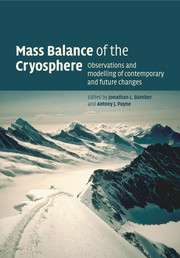Book contents
- Frontmatter
- Contents
- List of contributors
- Foreword
- Preface
- 1 Introduction and background
- Part I Observational techniques and methods
- 2 In situ measurement techniques: land ice
- 3 In situ measurement techniques: sea ice
- 4 Remote-sensing techniques
- Part II Modelling techniques and methods
- Part III The mass balance of sea ice
- Part IV The mass balance of the ice sheets
- Part V The mass balance of ice caps and glaciers
- Index
- References
4 - Remote-sensing techniques
Published online by Cambridge University Press: 16 October 2009
- Frontmatter
- Contents
- List of contributors
- Foreword
- Preface
- 1 Introduction and background
- Part I Observational techniques and methods
- 2 In situ measurement techniques: land ice
- 3 In situ measurement techniques: sea ice
- 4 Remote-sensing techniques
- Part II Modelling techniques and methods
- Part III The mass balance of sea ice
- Part IV The mass balance of the ice sheets
- Part V The mass balance of ice caps and glaciers
- Index
- References
Summary
Introduction
The cryosphere covers a vast expanse of the polar oceans and land surfaces. The area of the Southern Ocean covered by sea ice fluctuates between about 3.4 and 19.1 × 106 km2. over the period of one year. The Antarctic ice sheet covers an area of some 13 × 106 km2., greater than the conterminous USA. The number of glaciers on the planet is not well known, but certainly exceeds 160 000. Monitoring such large areas, often in remote and hostile environments, is ideally suited to satellite-based observations, which provide the only practical means of obtaining synoptic, timely coverage. Due to the importance of satellite remote sensing to observations of the cryosphere, we provide here a brief introduction to the subject, covering the satellites and sensors most commonly employed and describing how they can be used to derive information on mass balance. These instruments and techniques are referred to extensively in the subsequent chapters covering observational data on mass balance. This section is a primer in the subject. For comprehensive coverage of the general principles of remote sensing of the environment, the reader is referred to a number of excellent textbooks on remote sensing, referenced in this chapter. In section 4.2 we provide an overview of the general principles of satellite remote sensing, which are common to both land- and sea-ice measurements. In section 4.3 the characteristics and pertinent operating principles of the satellites and sensors relevant to cryospheric studies are reviewed.
- Type
- Chapter
- Information
- Mass Balance of the CryosphereObservations and Modelling of Contemporary and Future Changes, pp. 59 - 114Publisher: Cambridge University PressPrint publication year: 2004
References
- 9
- Cited by

